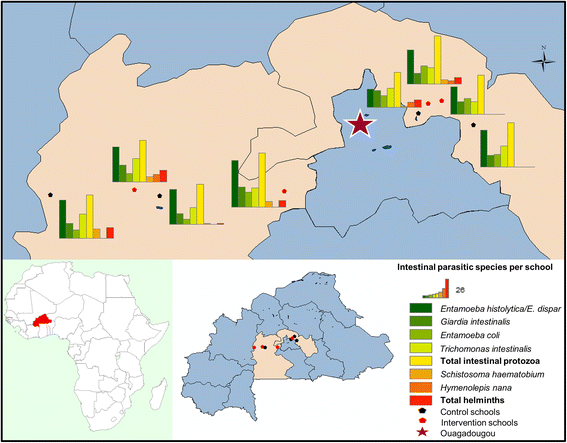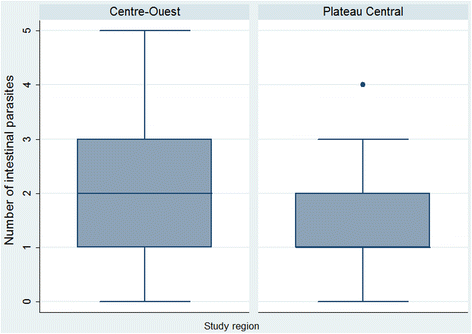Prevalence of intestinal parasitic infections and associated risk factors among schoolchildren in the Plateau Central and Centre-Ouest regions of Burkina Faso
- PMID: 27756339
- PMCID: PMC5069922
- DOI: 10.1186/s13071-016-1835-4
Prevalence of intestinal parasitic infections and associated risk factors among schoolchildren in the Plateau Central and Centre-Ouest regions of Burkina Faso
Abstract
Background: Unsafe drinking water, unimproved sanitation and lack of hygiene pose health risks, particularly to children in low- and middle-income countries. This study aimed to assess the prevalence and risk factors of intestinal parasitic infections in school-aged children in two regions of Burkina Faso.
Methods: A cross-sectional survey was carried out in February 2015 with 385 children aged 8-14 years from eight randomly selected schools in the Plateau Central and Centre-Ouest regions of Burkina Faso. Stool samples were subjected to the Kato-Katz and a formalin-ether concentration method for the diagnosis of helminths and intestinal protozoa infections. Urine samples were examined with a urine filtration technique for Schistosoma haematobium eggs. Water samples from community sources (n = 37), children's households (n = 95) and children's drinking water cups (n = 113) were analysed for contamination with coliform bacteria and faecal streptococci. Data on individual and family-level risk factors were obtained using a questionnaire. Mixed logistic regression models were employed to determine factors associated with intestinal parasitic infections in schoolchildren.
Results: Intestinal parasitic infections were highly prevalent; 84.7 % of the children harboured intestinal protozoa, while helminth infections were diagnosed in 10.7 % of the children. We found significantly lower odds of pathogenic intestinal protozoa infection (Entamoeba histolytica/E. dispar and Giardia intestinalis) among children from the Plateau Central, compared to the Centre-Ouest region (P < 0.001). Children from households with "freely roaming domestic animals" (P = 0.008), particularly dogs (P = 0.016) showed higher odds of G. intestinalis, and children reporting exposure to freshwater sources through domestic chores had higher odds of S. haematobium infection compared to children without this water contact activity (P = 0.035). Water quality, household drinking water source and storage did not emerge as significant risk factors for intestinal parasitic infections in children.
Conclusions: Intestinal protozoa but not helminths were highly prevalent among schoolchildren in randomly selected schools in two regions of Burkina Faso. Our findings call for specific public health measures tailored to school-aged children and rural communities in this part of Burkina Faso. It will be interesting to assess the effect of water, sanitation and hygiene interventions on the transmission of intestinal parasitic infections.
Trial registration: ISRCTN17968589 (date assigned: 17 July 2015).
Keywords: Burkina Faso; Helminths; Hygiene; Intestinal protozoa; Polyparasitism; Sanitation; Water.
Figures


References
-
- Utzinger J, Becker SL, Knopp S, Blum J, Neumayr AL, Keiser J, et al. Neglected tropical diseases: diagnosis, clinical management, treatment and control. Swiss Med Wkly. 2012;142. - PubMed
Publication types
MeSH terms
Substances
Associated data
LinkOut - more resources
Full Text Sources
Other Literature Sources
Medical
Miscellaneous

